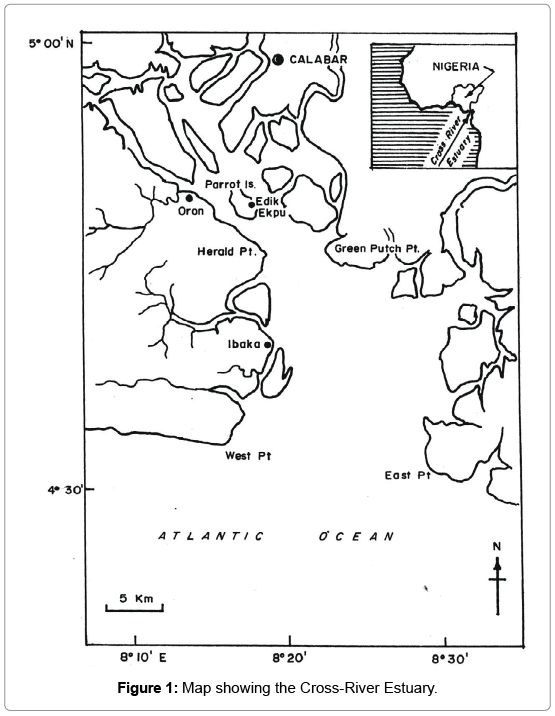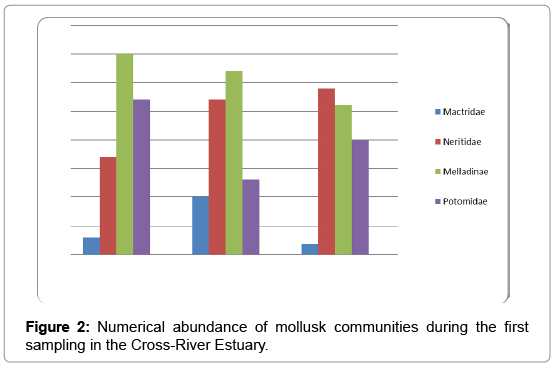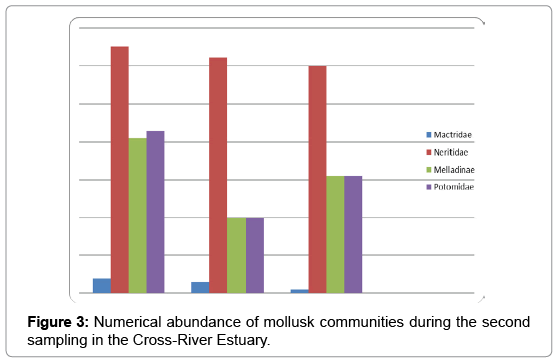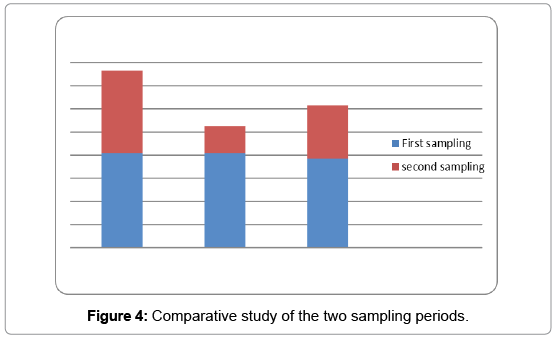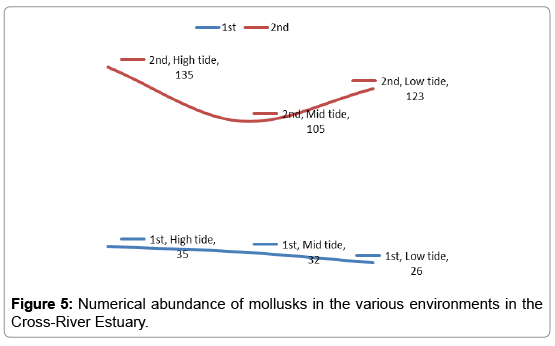Mollusk Response to Anthropogenic Impacts: An Example from Cross River Estuary, South Eastern Nigeria
Received: 17-Apr-2018 / Accepted Date: 14-May-2018 / Published Date: 18-May-2018 DOI: 10.4172/2157-7617.1000473
Abstract
The Mollusks of the Cross-River Estuary were sampled monthly between June and August during the rainy season using the direct search and litter-sieving methods. The results show that the extent of alteration of the natural ecosystem from anthropogenic activities could be deduced using the variations in numerical abundance and composition of mollusks in the environment. The most dominant mollusk communities in this study are represented by Neritina glabrata (30.29% during the first sampling and 49.08% during second sampling), Pachymeninx aurita (30.28% during the first sampling and 24.15% at second sampling), Tympanotonus Fuscatus (24.90% and 24.87% during the first and second sampling respectively) and Mactra glabrata (7.00% and 2.00% during the first and second sampling respectively). Low numerical abundance was recorded during the first sampling (241 individuals) as compared to the second sampling (381 individuals) which was attributed to the impacts of silt sedimentation caused by the dredging activities on the estuary in the first month of sampling. The general low diversity of mollusks assemblages recorded in this study reflects the strong impacts of anthropogenic activities. This study has demonstrated the fact that mollusk communities can be utilized as important marker for monitoring anthropogenic impacts and the state of health of the aquatic environment. The study however records various sampling variables due to the nature of the sampling methods. In order to obtain more precise data for a reliable assessment of anthropogenic impacts on the Cross-River Estuary, detailed study of the mollusks communities considering variables such as weather, season and salinity is therefore recommended.
Keywords: Anthropogenic impacts; Mollusks; Tides; Cross river; Estuary
Introduction
Estuaries are among the world’s most productive ecosystems associated with high diversity of invertebrate assemblages including mollusks as one of the dominant components in terms of species richness, biomass, and abundance. Estuaries are most commonly defined as semi-enclosed coastal bodies of water which has free connection with the open sea and within which sea water is measurably diluted with fresh water derived from land drainage. Most estuaries are formed during the first marine transgression in the Holocene approximately 15,000 years ago from existing river valleys flooded due to sea-level rise. Once sea-level stabilized to present levels about 6000 years ago estuaries have been infilling with sediments (at various rates) to assume its present feature. The rate of diversity and abundance of invertebrates and other organisms in the estuary is most commonly controlled by the rate of sedimentation, presence of contaminates such as metals and chlorinated compounds which bind to sediments, daily rise and fall of tides, salinity ranges and patterns of circulation amongst other factors [1]. Most benthic invertebrates including molluscs inhabit the intertidal zones of the coastal areas. Intertidal environment is defined as the zone between high and low water surrounding the world's oceans, supports a rich and unique biota consisting almost entirely of marine organisms. Intertidal organisms are exposed to air on a daily basis, and so must avoid or tolerate environmental stresses rarely encountered in the subtidal environment.
Molluscs are a diverse group of living organisms which evolved and diverged from a very simple and common ancestor to become one of the most successful animal phyla [2]. Molluscs are second only to Arthropoda in numerical abundance. The number of species identified under Phylum Mollusca vary between 80,000 to 1,00,000. Molluscs first appeared in geological history about 600 million years ago during the Cambrian period [2]. Molluscs have colonized all possible habitats from deep sea to high mountains. They are more abundant in the littoral zones of tropical seas. Gastropods and Bivalves constitute 98% of the total population of mollusca and they inhabit land, freshwater and marine environments. Molluscs are the most dominant animals in both aquatic and terrestrial environments. They are mostly active hunters, scavengers, passive filter feeders and deposit feeders attached to the substrate or living in burrows. Mollusc communities are common members of the shallow marine environments. The class Gastropoda, commonly known as snails, is successful organisms in both aquatic (marine, fresh and brackish water) and terrestrial environments. Molluscs along with other invertebrates are crucial parts of a properly functioning ecosystem [3]. Thus, slight impacts from anthropogenic activities may well be recognized from the distribution and abundances of these organisms [4,5].
The Cross-River Estuary provide ideal conditions for high production of molluscs, especially gastropods which are represented by snails, whelks, limpets, sea hares and their likes, they serve as food, for man and other organisms. Gastropods are predators naturally and as such occupy a central role in maintaining a functional and productive estuarine ecosystem by removing attached fauna like barnacles from roots of plants. The mollusks also serve as intermediate host for many trematode parasities, therefore the structure of mollusk assemblages, may be useful in assessing the extent of anthropogenic pollutants impacts in an estuarine environment. Mollusk compositions and abundance can also be useful indicators of ecosystem health and habitat quality, because of their critical ecosystem services, declines in mollusk communities may indicate broader problems with the health of the ecosystem. For example, increased silt sedimentation reduces the abundance of benthic invertebrates and species diversity richness [6] and lead to declining populations, such declines may forewarn of other ecological effects. Additionally, the limited mobility of most invertebrates, especially mollusks makes the presence of some species potential indicators of high quality, undisturbed habitat [7]. Gastropod species such as Tympanotonus Fuscatus is an important delicacy for most people in Nigeria as it provides cheap source of animal protein, vitamins and minerals [5] opined that this species of gastropods is very medicinal for cases like endemic goiter and pregnant women because it contains iodine, calcium, phosphate and iron content.
The Benthic macro invertebrates of the Cross-River Estuary have received only little attention in recent years. Yet, the estuary harbors, amongst others, a number of regionally threatened mollusc species, such as the gastropods Tympanotonus Fuscatus, Neritna glabrata, Thais califera, Littorina ssp. and Bivalves like Mactra glabrata and Ostra tulipa. Moreover, studies of aquatic invertebrates in other Nigerian coastal waters [5,8,9] did not pay attention to the influence of tidal cycles and anthropogenic impacts on the composition and abundance of this invertebrates on mudflats. Therefore, the present study is aimed at estimating the molluscan composition of the tidal marshes along the Cross-River estuary, determining the relationship between mollusk compositions and anthropogenic imputes and establishing the effects of tidal cycles on the mollusk communities.
Materials and Methods
Study area
The Cross-River estuary is located in the south-eastern Nigeria and lies between longitudes 8°001’E and 8°401’E of the Greenwich meridian and between latitudes 4°301’N and 5°151’N of the equator (Figure 1). The Cross river covers an estimated area of 54,000 km2 and is rich in fine grained materials, the estuary is one of the richest inland fisheries resources in Nigeria, based on its fish productivity [10] and about 90% of Nigeria’s total marine/brackish water output comes from this estuary [11]. The area under study belongs to the tropical rain forest region of southern Nigeria were rainfall is seasonal. The Estuary has suffered much impact from environmental pollution in recent years, especially from hydrocarbon exploration and exploitation [1], this however is a common situation in the area [1,12]reported that the Cross-River estuary is the largest in Nigeria, with tidal amplitude of 3M and is thus classified into three aquatic ecological habitats, ranging from fresh water in the upstream region through brackish water in the middle reaches to the marine environment at the mouth of the estuary.
Sampling and sampling techniques
For the purpose of this study, two stations were established between the high tide and the low tide region of the estuary, the distances covered by the low tide, mid tide and high tide (along the intertidal zone) was measured using a tape. Sampling was done on monthly bases beginning from June to August during the rainy season. Each station was searched thoroughly for two person’s hours (two people working for two hours). The estuarine mollusks were collected by hand picking in transect of known area, the direct search and litter-sieving methods by Tattersfield [13] was also applied. foulers like mussels and oysters were collected by scrapping with knives. The infaunals were collected by hand digging the substratum [14]. Additionally, water and soil samples were collected for detailed laboratory search and analyses. Identification of the mollusks was based on morphology and character of their shell such as shape, spire length, mouth opening, opercular shape, umbilicus shape and size, color and ornamentation. Measurements of these morphological parameters were made using veneer calipers. All live snails and other mollusks, and all empty shells were collected; live specimens were drowned and preserved in 70% ethanol.
Statistical analyses
Relative abundance. (RA) is the number of percent composition of an organism of a particular kind relative to the total number of organism in the area.

Results
Different tidal regimes during the periods of sampling are presented in (Tables 1 and 2). About 1449 individuals were collected during the study, 576 individuals were collected during the first sampling in August, while 923 individuals were collected at second sampling in October. The species of mollusks collected in the Cross- River Estuary at the time of sampling are Mactra glabrata(Mactridae), Neritina glabrata(Neritidae), Pachymelania aurita (Melaniidea) and Tympanotonus Fuscatus (Potomididae).
| Family | Organisms | Numerical abundance | |||||
|---|---|---|---|---|---|---|---|
| High-tide | Mid-tide | Low-tide | Total | % | |||
| Mactridae | M.glabrata | 3 | 10 | 2 | 15 | 7.00 | |
| Neritidae | N. glabrata | 17 | 27 | 29 | 73 | 30.29 | |
| Melladinae | P. aurita | 35 | 32 | 26 | 93 | 38.59 | |
| Potomidae | T. fuscatus | 27 | 13 | 20 | 60 | 24.90 | |
| Total | 82 | 82 | 77 | 241 | -- | ||
Table 1: Numerical abundance and percentage (%) composition of Mollusk community at different zones in the Cross-River Estuary at first sampling.
| Family | Organisms | Numerical abundance | |||||
|---|---|---|---|---|---|---|---|
| High-tide | Mid-tide | Low-tide | Total | % | |||
| Mactridae | M.glabrata | 4 | 3 | 1 | 8 | 2.09 | |
| Neritidae | N. glabrata | 65 | 62 | 60 | 187 | 49.08 | |
| Melladinae | P. aurita | 41 | 20 | 31 | 92 | 24.15 | |
| Potomidae | T. fuscatus | 43 | 20 | 31 | 94 | 24.87 | |
| Total | 153 | 105 | 123 | 381 | -- | ||
Table 2: Numerical abundance and percentage (%) composition of Mollusk community at different zones in the Cross-River Estuary at second sampling.
During the high tide, about 615 mollusc assemblages were collected, the most abundant was Neritina glabrata with relative abundance of 33.17%, followed by Tympanotonus Fuscatus (32.36%), Pachymelania aurita (31.71%) and Mactra glabrata (2.76%). In the Mid tide, a total of about 453 individuals were collected, this was dominated by Neritina glabrata with relative abundance of 47.02% followed by Tympanotonus Fuscatus (25.39%), Pochymelania aurita (21.63%) and Mactra glabrata (5.96%). 431 individuals were collected during the low tide with Neritina glabrata being the dominant species with relative aboundance of 35.73%, followed by Pachymelania aurita (30.86%), Tympanotonus Fuscatus (27.84%) and Mactra glabrata (5.57%).
At first sampling, Pachymelania aurita was the dominant individuals; this was followed by Neritina glabrata, Mactra glabrata and Pachymelania aurita (Table 1, Figure 2). Highest number of individuals was recorded for Neritina glabrata during the second sampling, followed by Tympanotonus Fuscatus and Mactra glabrata (Table 2, Figure 3). Generally low numerical abundance and diversity was observed in the environments sampled in the Estuary during this study. Close observation of the patterns of distribution of molluscs in the estuary shows that higher number of individuals occurred in high tide when compared to the mid and low tides and that the number of individuals increased significantly in the second sampling (Figures 4 and 5).
Discussion
The results of this study clearly indicate a change in the composition of the mollusks assemblages of the tidal mud flats along the Cross-River estuary. The four species of mollusks obtained are quite distinctive in terms of their abundances in the different tidal regimes. Tides seem to be an important factor contributing to the distribution of this fauna but are certainly not the only one as the alternation of aquatic and terrestrial phases in the marshes creates a diversity of micro-habitats in this organism. Other factors are the differences between the, aquatic and dry terrestrial environment, the frequency of flooding, vegetation, water temperature, soil texture, presence of other organisms can as well influence the mollusk assemblages in the sampling environment. However, the findings of this study showed that mollusk communities can be used as proxies of the whole ecosystem health in accessing anthropogenic impacts. The number of individual mollusk recorded was generally very low, this may have been as a result of alteration of the natural ecology resulting from human related activities in the surrounding environment. During the first sampling, dredging activities were carried out in the estuary which resulted to increased silt sedimentation. Increase in silt sedimentation has been reported to be responsible for the reduction in abundances of benthic invertebrates and species diversity richness [6]. In addition, high human activities around the sampling stations could be a possible explanation for the low numerical abundances of mollusks in the estuary. reported that high biodiversity is expected in ecosystems devoid of significant anthropogenic impacts especially regions that are far away from human reach. The low tide environments tend to have lower organisms than the high tide regions during the period of this study. This may be due to the present of sandy and muddy substrate in the high tide regions which accumulates organic matters that are favorable for the mollusk productivity; also, the low tide has abundant of muddy substrates this could accumulate more organic matter which favors the abundances of the mollusks, but this condition tends to have been altered due to the introduction of human induced wastes. Estuaries are also extreme environment for most organisms to cope as both marine and fresh water conditions prevail at certain extents in the environment this could also have affected the low diversity of mollusk community observed in this study.
During the second sampling, high numerical abundance of mollusk was observed, when compared to the first sampling (Figure 4). This demonstrates the fact that dredging activities have seized in the estuary and hence a reduction in silt sedimentation providing a favorable condition for the mollusks to strive [6]. The variability in mollusk communities along the tidal regions contributed to the absence of a perfect indicator of the impact of anthropogenic activities in the estuary. Results from this study showed that the most abundant mollusk fauna are Pachymelania aurita (Melaniidea) and Neritina glabrata(Neritidae). These mollusks may well be adapted to the prevailing environmental conditions than the others. However, due to the variability of the sampling methods used in this study, good account for other variables especially season and weather which also affects the distribution and abundances of benthic organisms were not presented. High abundance of mollusk communities is observable in regions that are free from anthropogenic impacts such as solid municipal effluents, wastes products of hydrocarbons and their derivatives that occur in the form of a thin-coat of oil that spreads over a considerable distance in the water. Where these conditions exist, numerical abundance of mollusks was found to be low. This condition hinders primary productivity and hence the transfer of energy into the various trophic levels in the estuary, this finding agrees with previous studies in the area [5,6,15].
Conclusion
In conclusion, mollusks possess important characteristics in aquatic environments, not just because of the critical role they play in aquatic ecosystem, they can be utilized as important marker for monitoring anthropogenic impacts and the state of health of the aquatic environment. Mollusk species have been used extensively in recent years as bioindicators organisms this is as a result of the continuously anthropogenic-induced impacts on the environmental health status of the aquatic environment. The cross-river Estuary is one of such environment that have been altered extensively as a result of discharge of pollutants from the nearby industries as well as from oil spillage. The low numerical abundances of mollusks in the estuary clearly demonstrate the extent of anthropogenic impact in the environment. During this study, only random samples were taken. This may have altered the sample because mollusk communities can be very patchy. Moreover, gastropod activity depends strongly on the conditions of the weather [16], slugs and snails become inactive during cold and dry conditions and hide in the substrates. The study records a lot of sampling variables which are not controlled. This study therefore recommends detailed study in order to obtain more precise data on species abundances and distributions, before a reliable assessment can be made on the response of molluscan communities to anthropogenic impacts in the Cross-River estuary. Nevertheless, the low numerical abundance of mollusk in this estuary is an indication of the effects of human related activities in the area [17-19].
Acknowledgement
The authors are indeed grateful to the Faculty of Oceanography, University of Calabar for providing the enabling environment for this study
References
- Asuquo FE, Eja ME, Ekwu AO, Bassey ES (1998) Post Impact Assessment (PIA) of Cross River coastal areas affected by Mobil (Idoho) oil spill. Report submitted to Cross River State Government 68.
- Doyle P (1996) Understanding fossils: An introduction to invertebrate palaeontology. Willey and Sons 136.
- Lydeard C, Cowie RH, Ponder WF, Bogan AE, Bouchet P, et al. (2004) The global decline of nonmarine mollusks. BioScience54:321-330.
- Okorafor KA, Andem AB, Okete JA, Ettah SE (2012) The composition, distribution and abundance of macroinvertebrates in the shores of the Great Kwa River. European Journal of Zoological Research 1:31-36
- Ewa-Oboho IO (2006) Ecological effects of channelization on a tropical marine ecosystem: Impacts on intertidal fish communities in the Cross River. West African Journal of Applied Ecology 9: 37- 50
- Hotopp KP (2002) Land snails and soil calcium in central. Appalachian Mountain forest 47:81-92.
- Andem AB, Udofia UU, Okorafor KA, George UU (2013) Bioaccumulation of some heavy metals and total hydrocarbon (THC) in the tissues of periwinkle (TympanotonusFuscatus Var Radula) in the intertidal regions of Qua Iboe River Basin. Greener Journal of Biological Sciences. 3:253-259.
- Okorafor KA, Effanga EO, Andem AB, George UU, Amos DI (2013) Spatial variation in physical and chemical parameters and macro-invertebrates in the intertidal regions of calabar river. Greener Journal of Geology and Earth Sciences 2: 63-72
- Moses BS (2000) A review of artisanal fisheries of south eastern Nigeria. Fisheries Research Conserv 8:1-5.
- Moses BS (1999) Socio-economic importance of biological conservation. Trans Nig Soc Biol.
- Ekeh IB, Sikoki FD (2004) Diversity and spatial distribution of phytoplankton in new calabar river. Liv Sys Sus Dev 1: 25-31.
- Tattersfield P (1996) Local patterns of land snail diversity in a Kenyan rain forest. Malacologia38: 161-180
- Alfred JB, Varshney RK, Ghosh AK (1997) An assessment manual for faunal biodiversity in south Asia. SACEP/NORAD publication series on biodiversity in South Asia 1: 181.
- Ewa- Oboho IO, Olamideji S (2004) Acute ecological effects of exxonmobilidoho platform: January 12, 1998 crude oil discharge on inter-tidal fauna of South Atlantic Coastline. Tropical Environment Research 5:371-383.
- Bruyndoncx L, Jordaens K, Ysebaert T, Meire P, Backeljau T (2002)Molluscan diversity in tidal marshes along the Scheldt estuary. Hydrobiologia474:189-196.
- Ekwu AO, SIKOKI FD (2006) Phytoplankton diversity in the Cross-River Estuary of Nigeria. Journal of Applied Science and Environmental Management 10:89-95
- Sikoki FD, Zabbey N (2006) Environment gradients and benthic community of the middle reaches of Imo river. Environment and Ecology 24:32-36
- Ubom RM, Essien JP (2003) Distribution and significance of episammicalgae in the coastal shore (Ibenobeach) of Qua Iboe River Estuary. The Environmentalist 23:109-115.
Citation: Timothy A (2018) Mollusk Response to Anthropogenic Impacts: An Example from Cross River Estuary, South Eastern Nigeria. J Earth Sci Clim Change 9: 473. DOI: 10.4172/2157-7617.1000473
Copyright: © 2018 Timothy A. This is an open-access article distributed under the terms of the Creative Commons Attribution License, which permits unrestricted use, distribution, and reproduction in any medium, provided the original author and source are credited.
Select your language of interest to view the total content in your interested language
Share This Article
Recommended Journals
Open Access Journals
Article Tools
Article Usage
- Total views: 6728
- [From(publication date): 0-2018 - Nov 07, 2025]
- Breakdown by view type
- HTML page views: 5716
- PDF downloads: 1012

